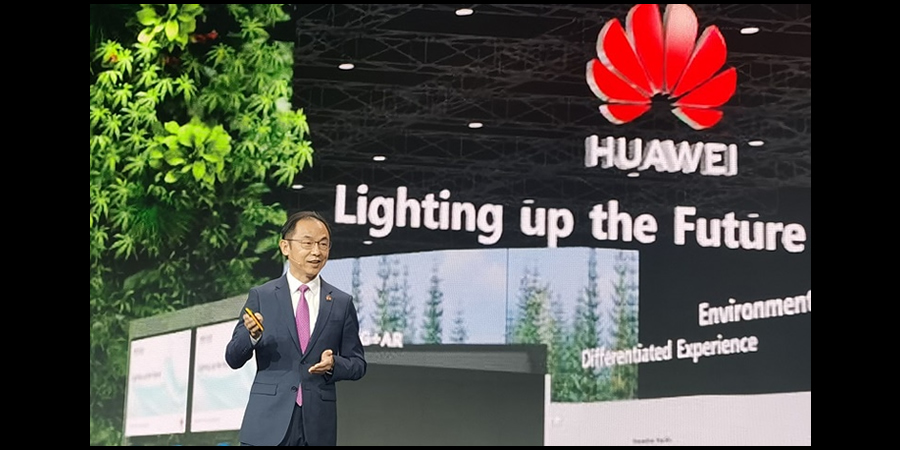Addressing a key note speech titled ‘Innovation: Lighting up the Future’ during MWC Barcelona 2021, Huawei executive director and president of carrier BG, Ryan Ding said that innovation in ICT is becoming a key driver of the global economy and its value is moving beyond the telecoms industry.
Ding pointed out that the pandemic has highlighted ICT infrastructure as the cornerstone of the digital economy and has transformative implications for the global economy as a whole.
He said countries with advanced 5G infrastructure such as South Korea, China and Europe were witnessing faster revenue growth. He cited the example of China where, in less than 18 months, more than 820,000 5G base stations have been deployed, and Chinese operators have achieved a 6.5% increase in revenue and a 5.6% increase in net profits in the first quarter this year.
Ding also highlighted the important role of operators in the digital economy in the 5G era.
"Currently, the major goal of operators in 5G is to achieve business success in three key markets – consumers, homes, and industries – through innovation in network deployment, market development, and operation optimization." he said.
According to Ding, there are three steps an operator can take to succeed in the 5GtoC market. The first is to speed up 5G deployment, with targeted network planning and investment based on precise insights into high-value areas, key scenarios, and potential users. The second is to accelerate 5G user migration, and the third step is to create value-driven, flexible pricing models.
Today, 5G has been applied in over 1,000 projects in more than 20 industries including steel and mining, enabling safer and more efficient production. Chinese operators have made great progress and are entering the phase of taking early successes and replicating them at scale.
"We've learned from Chinese operators' experience that the success of 5GtoB depends on three factors," said Ding. "First, selecting the right industries. Operators should choose target industries by looking at four factors: demand, affordability, replicability, and technical feasibility. Second, defining the scope of your offerings. Operators can serve as network providers that offer connectivity services. They can also serve as cloud service providers, or even system integrators that provide end-to-end integration services. Different roles require different skillsets and yield different business value. Third, designing innovative business models. This is key to replicating 5GtoB success at scale."
Ding also touched upon who Huawei’s innovation to drive industry-wide sustainability.
"5G success first requires a 5G network that provides the best user experience, and this guides how we innovate at Huawei," said Ding. He mentioned Huawei’s launch of the industry's lightest and most powerful Massive MIMO that consumes less energy. He highlighted Huawei's Optical Cross-Connect (OXC), one sub-rack that can replace nine cabinets normally needed. It has four times larger capacity, but uses 95% less power. Huawei's 5G Super Uplink solution combines the advantages of 2.1 GHz and 3.5 GHz to enhance uplink capacity and indoor coverage. This solution provides a peak uplink rate of over 450 Mbit/s, enabling hundreds of users to live stream the Xiamen Marathon in 4K in April using their 5G smartphones.
To support green development models and carbon neutrality, according to Ding, Huawei keeps innovating at three levels: equipment, sites, and networks. At the equipment level, Huawei uses components with higher power efficiency to make hardware platforms more energy efficient. At the site level, Huawei's simplified site solutions help operators lower energy consumption, as well as save on electricity and rent. At the network level, Huawei has launched a multi-band and multi-RAT power saving solution. This solution can cut energy consumption in wireless networks without compromising network performance.
In conclusion, Ding emphasized that 5G development requires ongoing innovation. In 5GtoB, for example, 5G standards need to be coordinated with industry standards at a faster rate, and 5G should be integrated into enterprises' core production processes to help them go digital and intelligent. At the same time, the synergy between 5G, cloud, and computing will further expand the boundaries of operators' business, creating space for new growth. 5G innovation is an ongoing process. Huawei believes that innovation will light up the future.
Separately, during MWC Barcelona 2021, Huawei launched a series of 5G products and solutions oriented to "1+N" 5G target networks. Supercharged by industry-leading innovation, these products and solutions will help promote multi-antenna technology to all bands and all scenarios to build leading 5G networks. The products included: Industry’s only 400 MHz Ultra-Wideband 64T64R Massive MIMO, Industry's Lightest 64T64R Massive MIMO, BladeAAU Pro: Industry's Only 64T A+P Solution, BladeRRU Pro: Industry's Only RF Unit That Supports Three Low and Three Medium Bands, and Industry's Only Commercial FDD Massive MIMO.
Yang Chaobin, president of Huawei Wireless Product Line, said, "By launching this series, we aim to bring multi-antenna technology to all scenarios and bands. Several products within the solutions are one-of-a-kind and will help operators efficiently deploy 5G networks and provide first-rate experience. Huawei will work with global partners to innovate and share 5G benefits with all."










